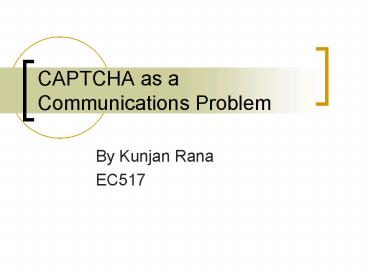CAPTCHA as a Communications Problem - PowerPoint PPT Presentation
1 / 20
Title:
CAPTCHA as a Communications Problem
Description:
Automated process for determining whether an internet form submission is ... We can find the capacity (albeit inefficiently) using its definition: ... – PowerPoint PPT presentation
Number of Views:89
Avg rating:3.0/5.0
Title: CAPTCHA as a Communications Problem
1
CAPTCHA as a Communications Problem
- By Kunjan Rana
- EC517
2
What Is a CAPTCHA?
- Completely
- Automated
- Public
- Turing test to tell
- Computers and
- Humans
- Apart
3
Purpose of CAPTCHAs
- Automated process for determining whether an
internet form submission is completed by a
legitimate human user or a malicious bot - Most common form is a visual CAPTCHA (in image)
4
Motivation
- Almost every major web application uses a visual
CAPTCHA - Many visual CAPTCHAs are easily crackable, since
there is currently no analytical method for
studying the limits of detection for various
CAPTCHA schemes
Easy to crack! ?
5
Though the Lens of IT
6
Immediate Consequences of the new methodology
- Easier to visualize problem of detection
Increase the amount of computation necessary on
the detector side, but make the increases of
computation trivial for human detectors (increase
alphabet of Y by increasing alphabet of X and/or
increasing channel distortion possibilities)
7
Evolution of CAPTCHAs
8
Some CAPTCHAs have features that reduce
randomization
- Examples
- Limiting the variations of letters to english
words decreases entropy of the source since it is
no longer a uniform distribution of the letters
9
Some CAPTCHAs are very difficult for humans to
detect
10
Some CAPTCHAs are impossible for humans to detect
11
What can the capacity of this channel tell us?
- A capacity equal to log X for this channel
would show that all output from the channel is
potentially decodable by a human observer - Programmer can design distortions based upon this
measure - However, humans are sub-optimal decoders, so this
does NOT tell us if humans can decode the image
12
How can we find it?
- We can find the capacity (albeit inefficiently)
using its definition - Then, we can observe overlapping outputs
13
Geometric Distortions
- For the purposes of this project, I focused on
warping transformations
14
Method
- Take fixed alphabet W for input and generate a
single 8x8 image corresponding to each
(generating X)
A B C D
15
Find all possible transformations
- Find a mapping between the old coordinate system
(x1,y1) to the new one (x2,y2)
16
Dealing with non-integer (x2,y2)
- Distribute the original values intensity among
neighboring points - Example given 2x2 grid and shift of x of 0.25
and shift of y of 0.75
17
Result
- The system achieved capacity for up to 2 pixels
moved in each direction (although this does not
mean that the other cases were distinguishable
for a human observer)
18
Too much work for a simple answer!
- Number of computations become exponentially large
as size of image and bounds on distortion grow.
19
Other limitations of model
- This system treats the input and output as a
one-channel-use problem. In reality, many OCRs
segment the image into individual letters. So, W
can be modeled as a random process with a smaller
alphabet. - Also, some distortion systems (channels) have
knowledge of their input, and will bound the
amount of distortion based upon this information
20
Future Directions
- Treatment of geometric distortions as time-warped
data, or correlations between inputs - Quantization of values and power limitation of
the pixel intensity































